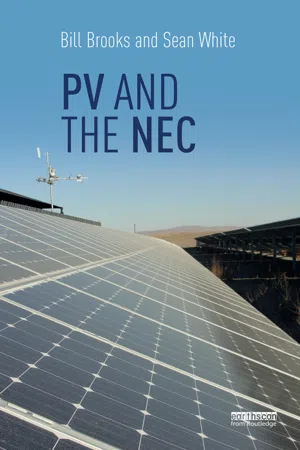
- 208 pages
- English
- ePUB (mobile friendly)
- Available on iOS & Android
PV and the NEC
About this book
Used throughout the United States and many other countries, the National Electric Code (NEC) is the world's most detailed set of electrical codes pertaining to photovoltaic (PV) systems.
Photovoltaic Systems and the National Electric Code presents a straightforward explanation of the NEC in everyday language. The new book is based on the 2017 NEC, which will be used widely until 2023, with most of the interpretations and material staying true long after. This book interprets the distinct differences between previous versions of the NEC and the 2017 NEC and clarifies how these Code changes relate specifically to photovoltaic installations.
Written by two of the leading authorities and educators in the field, this book will be a vital resource for solar professionals, as well as anyone preparing for a solar certification exam.
Frequently asked questions
- Essential is ideal for learners and professionals who enjoy exploring a wide range of subjects. Access the Essential Library with 800,000+ trusted titles and best-sellers across business, personal growth, and the humanities. Includes unlimited reading time and Standard Read Aloud voice.
- Complete: Perfect for advanced learners and researchers needing full, unrestricted access. Unlock 1.4M+ books across hundreds of subjects, including academic and specialized titles. The Complete Plan also includes advanced features like Premium Read Aloud and Research Assistant.
Please note we cannot support devices running on iOS 13 and Android 7 or earlier. Learn more about using the app.
Information
1
Article 690 photovoltaic (PV) systems
Part I general (part)
- 690.1 Scope [Section 690.1]
- 690.2 Definitions [There are more NEC definitions in Article 100, such as the definitions for PV, ac and dc.]
- 690.4 General Requirements [They could not come up with a better title for this category.]
- 690.6 Alternating Current (ac) Modules

Part II circuit requirements
- 690.7 Maximum Voltage
- 690.8 Circuit Sizing and Current
- 690.9 Overcurrent Protection [Article 240 is also Overcurrent Protection.]
- 690.10 Stand Alone Systems [This has been moved to Article 710 in the 2017 NEC.]
- 690.11 Arc-Fault Circuit Protection (Direct Current)
- 690.12 Rapid Shutdown of PV Systems on Buildings [Big changes]
Part III disconnecting means
- 690.13 Photovoltaic System Disconnecting Means
- 690.15 Disconnection of PV Equipment
Part IV wiring methods
- 690.31 Methods Permitted
- 690.32 Component Interconnections
- 690.33 Connectors
- 690.34 Access to Boxes
Part V grounding and bonding [Article 250 is also grounding and bonding.]
- 690.41 System Grounding [Big changes in the 2017 NEC]
- 690.42 Point of System Grounding Connections
- 690.43 Equipment Grounding and Bonding
- 690.45 Size of Equipment Grounding Conductors
- 690.46 Array Equipment Grounding Conductors
- 690.47 Grounding Electrode System [Experts argue over a lot of this article, which is interesting to observe.]
- 690.50 Equipment Bonding Jumpers
Part VI marking
- 690.51 Modules
- 690.52 Alternating Current Photovoltaic Modules
- 690.53 Direct Current Photovoltaic Power Source
- 690.54 Interactive System Point of Interconnection
- 690.55 Photovoltaic Systems Connected to Energy Storage Systems
- 690.56 Identification of Power Sources [This includes new Rapid Shutdown signs.]
Part VII connection to other sources
- 690.59 Connection to Other Sources [Directs us to Article 705]
Part VIII energy storage systems
- 690.71 General [Directs us to Article 706]
- 690.72 Self-Regulated PV Charge Control
Article 690 solar photovoltaic (PV) systems Part I general (part)
690.1 scope (section 690.1)


![Figure 1.4 Interactive system [2017 NEC Fig 690.1(b)]](https://book-extracts.perlego.com/1576697/images/fig1_4-plgo-compressed.webp)
![Figure 1.5 Ac module system [2017 NEC Fig 690.1(b)]](https://book-extracts.perlego.com/1576697/images/fig1_5-plgo-compressed.webp)
![Figure 1.6 Dc coupled multimode system [2017 NEC Fig 690.1(b)]](https://book-extracts.perlego.com/1576697/images/fig1_6-plgo-compressed.webp)
Table of contents
- Cover
- Half Title
- Title
- Copyright
- Contents
- List of figures
- List of tables
- Introduction
- 1 Article 690 photovoltaic (PV) systems
- 2 Article 690 photovoltaic systems part II circuit requirements
- 3 Section 690.12 rapid shutdown
- 4 Article 690 part III disconnecting means
- 5 Article 690 part IV wiring methods
- 6 Article 690 part V grounding and bonding
- 7 Article 690 part VI to the end of 690
- 8 Article 691 large-scale photovoltaic (PV) electric power production facility
- 9 Article 705 interconnected electric power production sources
- 10 Storage articles
- 11 Chapters 1–4, Chapter 9 tables and Informative Annex C
- 12 PV wire sizing examples
- Index